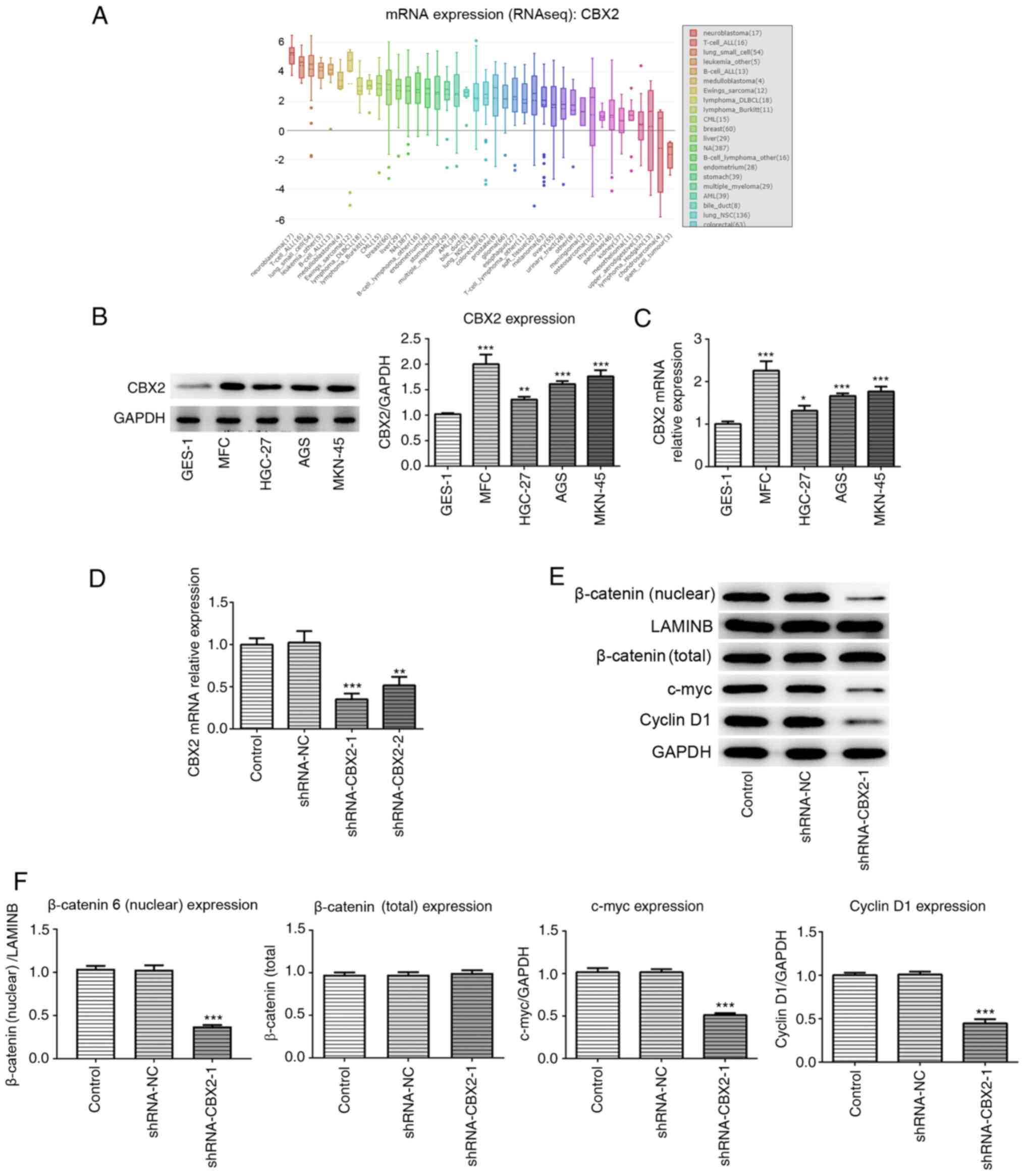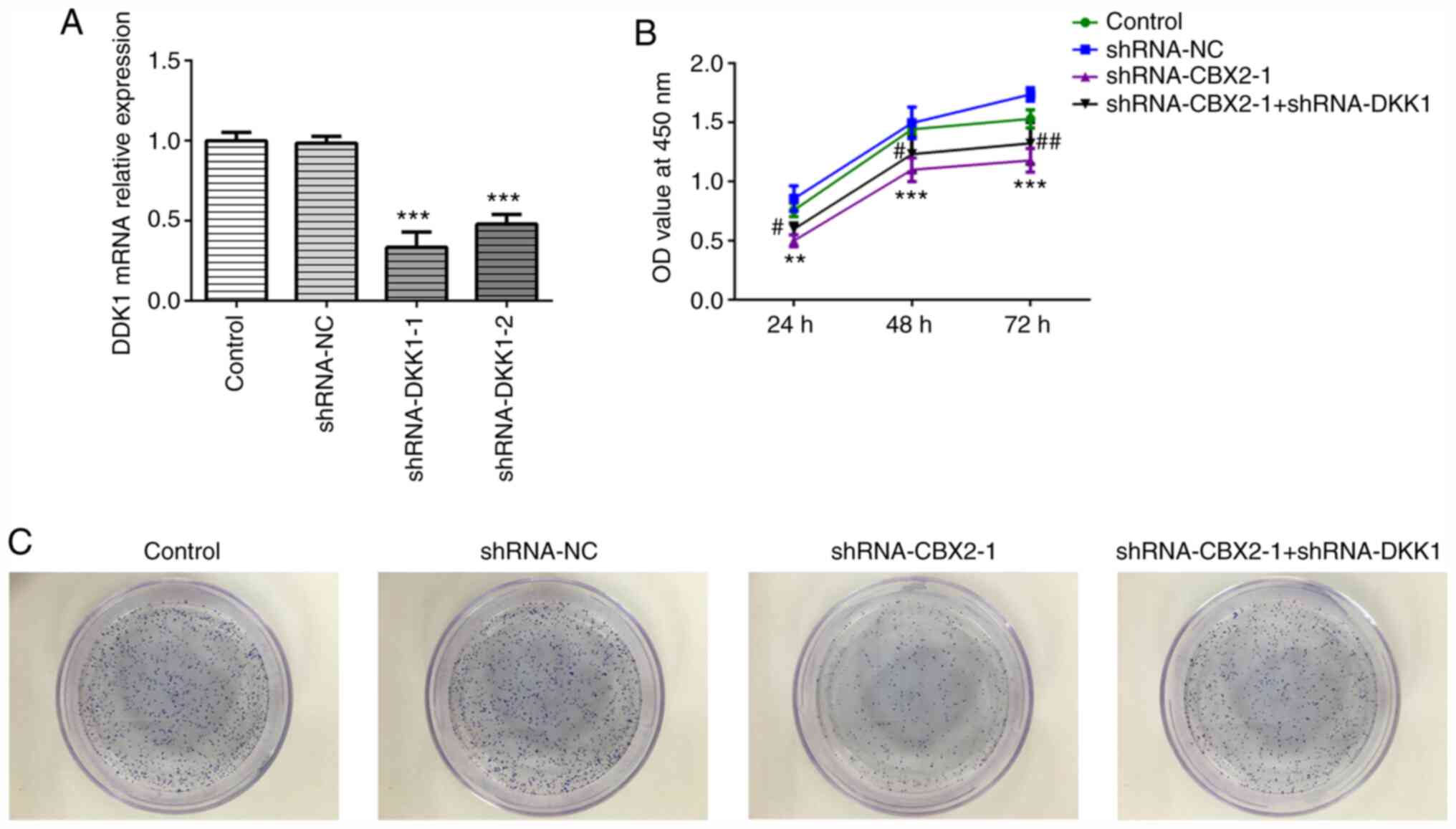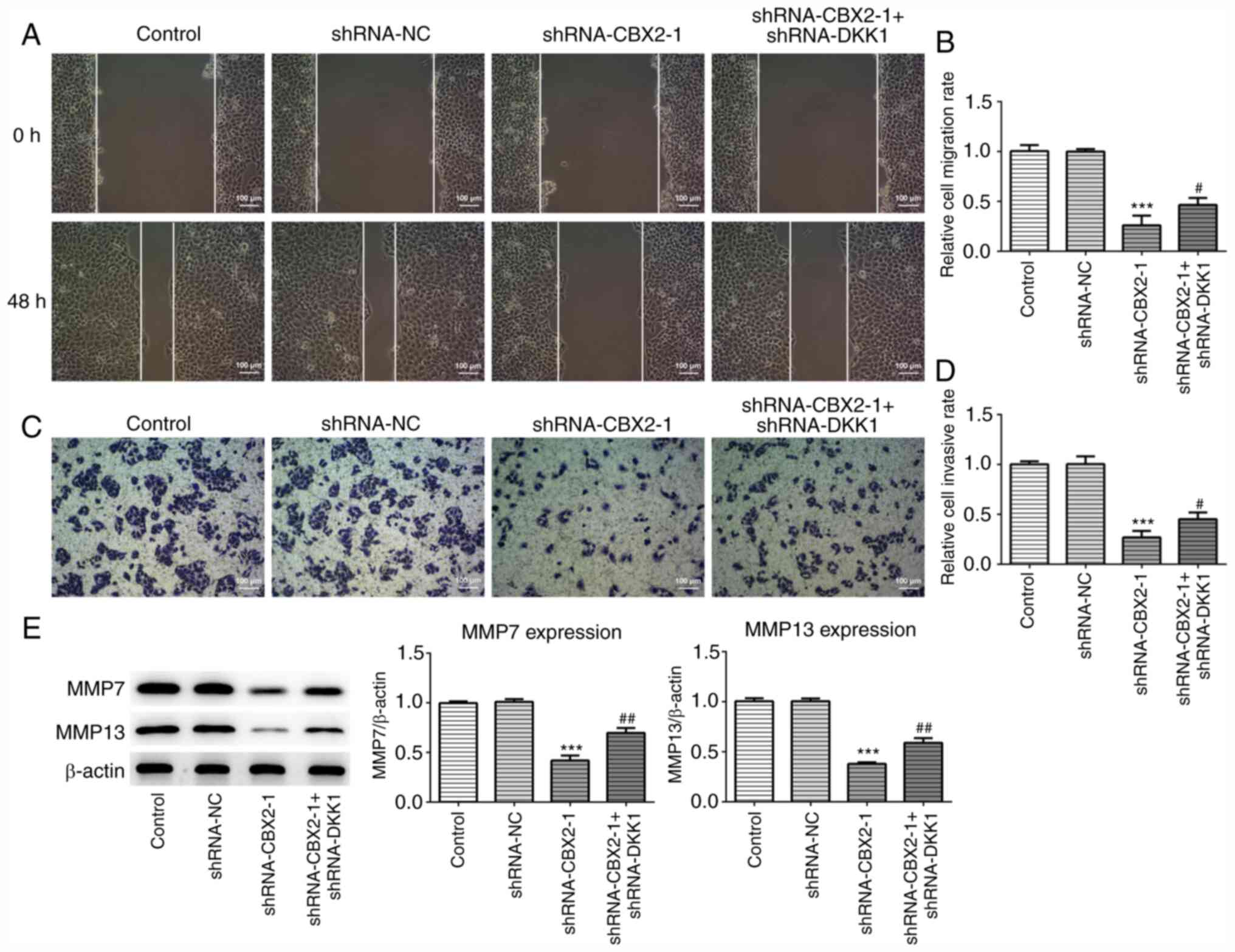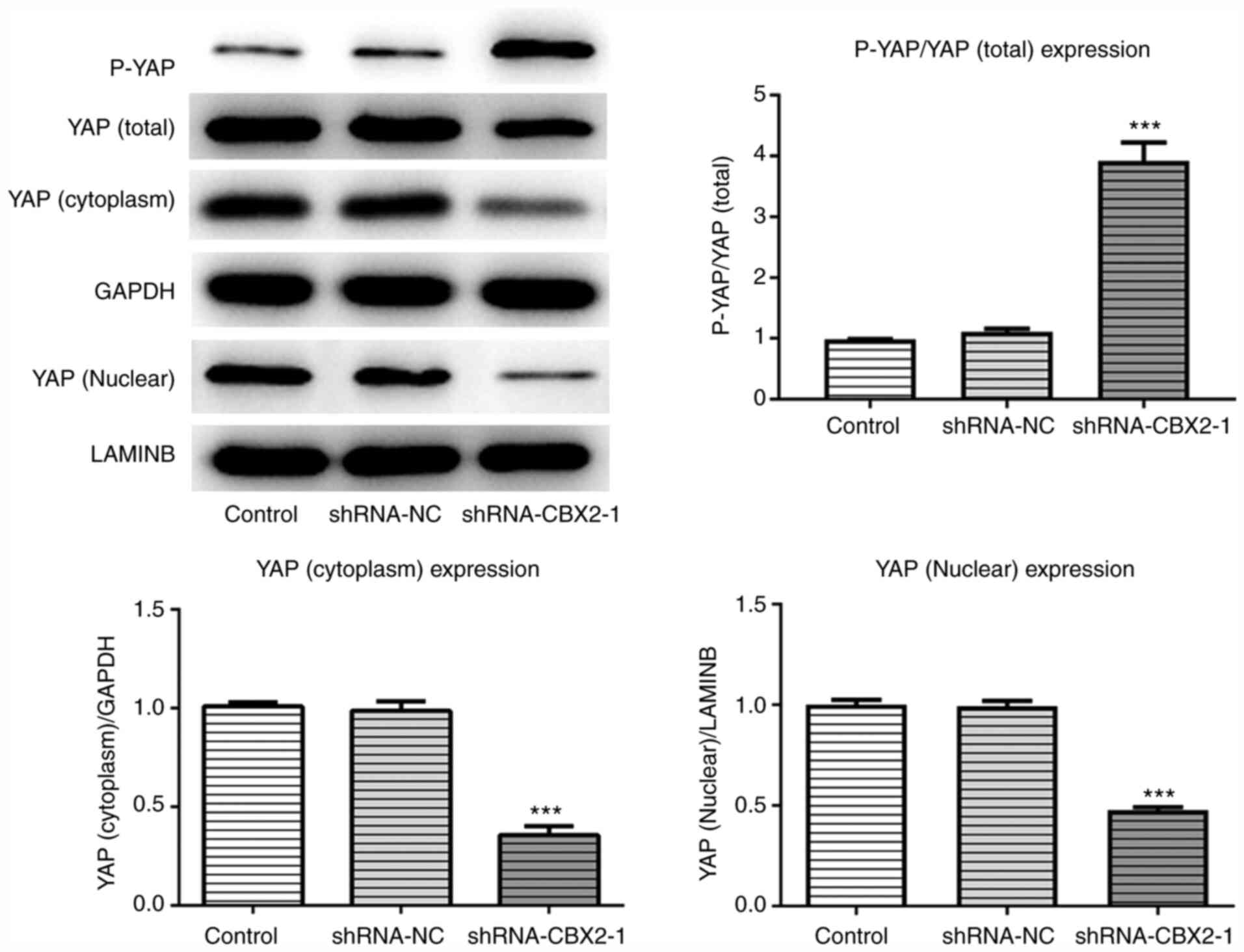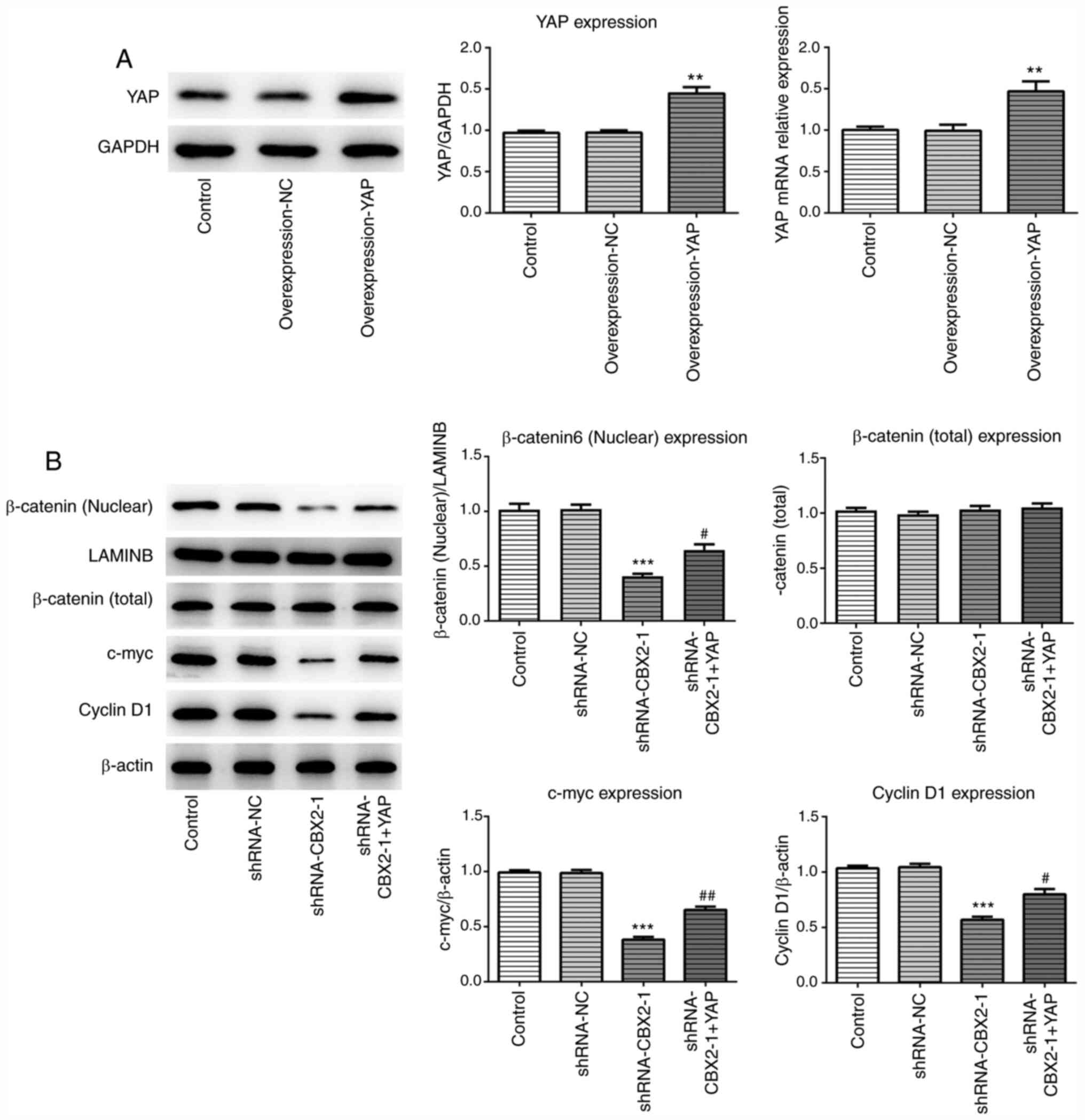CBX2 depletion inhibits the proliferation, invasion and migration of gastric cancer cells by inactivating the YAP/β-catenin pathway
- Authors:
- Published online on: December 13, 2020 https://doi.org/10.3892/mmr.2020.11776
- Article Number: 137
-
Copyright: © Zeng et al. This is an open access article distributed under the terms of Creative Commons Attribution License.
Abstract
Introduction
Gastric cancer (GC) is the third leading cause of cancer-related death (after lung and colorectal cancer) worldwide and is the most common and fast-growing malignancy of the digestive system with a high mortality (1,2). It is estimated that >1,000,000 new cases of GC were diagnosed (5.7% of the overall cancer incidence) and 800,000 deaths occurred (8.2% of all cancer mortalities) in 2018 worldwide (3). Furthermore, according to previous studies, patients with GC regularly exhibit partial metastasis at diagnosis or during chemotherapy (4,5). Despite advances in GC diagnostic techniques, surgery and neoadjuvant chemoradiotherapy, the 5-year survival rate remains poor in China, particularly at advanced stages (6,7). Owing to the complexity of the pathogenesis of GC, its underlying molecular mechanisms remain unclear. CBX2 is widely considered to be a tumor-promoting gene (8,9). Due to its significant association with large tumor size and lymph node metastasis, it has been reported that CBX2 is highly expressed in breast cancer tissues compared with adjacent normal tissues and may serve as a novel biomarker for predicting the prognosis of patients with breast cancer (10). Additionally, CBX2 has been demonstrated to be upregulated in patients with metastatic castration-resistant prostate cancer, which was closely associated with a poor prognosis (11). Furthermore, high CBX2 expression is associated with poor clinical outcomes in hepatocellular carcinoma, with CBX2 serving regulatory effects on proliferation and apoptosis via the phosphorylation of yes-associated protein (YAP) in hepatocellular carcinoma cells (12). However, the precise function of CBX2 in GC remains unclear.
As a transcription co-activator of the Hippo family, YAP is a mechanotransduction protein that serves a key role in proliferation, differentiation and organ size (13–15). Emerging evidence has determined that abnormal YAP activation is involved in the growth of certain tumors, including liver and prostate cancer (16,17). A previous study demonstrated that CBX2 knockdown suppressed hepatocellular carcinoma cell proliferation and promoted apoptosis by increasing the phosphorylation of YAP (12). YAP1 overexpression has also been demonstrated to promote the proliferation and migration of bladder cancer cells (18). In addition, increasing evidence has revealed that the aberrant activation of Wnt/β catenin signaling serves a key role in promoting the tumorigenesis and progression of cancer (19). More importantly, YAP has the ability to induce the nuclear localization and accumulation of β-catenin (20). It is therefore hypothesized that CBX2 knockdown may inhibit the expression of β catenin signaling by promoting the phosphorylation of YAP and its translocation into the nuclear cytoplasm, which may further inhibit the proliferation, invasion and migration of GC cells.
The aim of the present study was to investigate the biomolecular role and underlying mechanism of CBX2 in GC progression. Thus, GC cell lines were transfected with short hairpin (sh)RNA-CBX2, which was constructed to regulate the expression of CBX2. It was determined that CBX2 knockdown by shRNA inhibited GC cell proliferation, invasion and migration. Thus, CBX2 may serve as an effective target for clinical GC therapy. The present study aimed to investigate the biomolecular role of CBX2 and its underlying mechanism in the pathogenesis of GC.
Materials and methods
Cell culture and transfection
Normal gastric GES-1 cells, a mouse gastric carcinoma cell line (MFC) and various human GC cell lines including, HGC-27, AGS and MKN-45 were obtained from the American Type Culture Collection. Each cell line was maintained in DMEM/F12 1:1 medium (HyClone; Cytiva) supplemented with 10% FBS (HyClone; Cytiva) and incubated at 37°C with 5% CO2, as previously described (21,22). Cells were split every 3 days and were diluted 1 day before each experiment. The expression of CBX2 in GC cell lines was analyzed using the Cancer Cell Line Encyclopedia (CCLE; portals.broadinstitute.org/ccle).
shRNA-CBX2, shRNA-dickkopf-related protein 1 (DKK1) and negative control (NC) shRNA plasmids cloned into the PLL3.79 lentiviral vector were constructed by Shanghai GenePharma Co., Ltd. Lentiviruses (10 µg/ml) were transduced into MFC cells (2×104/well) for 36 h. The sequences of shRNA-CBX2 and shRNA-DKK1 used were as follows: shRNA-CBX2-1, 5′-GCTGGTCCTCCAAACATAACA-3′; shRNA-CBX2-2, 5′-GGCCTTCCAGAAGAAGGAACA-3′; shRNA-DKK1-1, 5′-GCTCTCATGGACTAGAAATAT-3′; shRNA-DKK1-2, 5′-GGAATAAGTACCAGACCATTG-3′; and shRNA-NC, 5′-TTCTCCGAACGTGTCACGT-3′. YAP-overexpression plasmids and control overexpression plasmids cloned into the pCDNA3.1 vector were provided by Shanghai GenePharma Co., Ltd. MFC cells (2×104/well) were transfected with 100 pmol pcDNA-3.1 vectors using Lipofectamine® 2000 (Invitrogen; Thermo Fisher Scientific, Inc.) for 36 h according to the manufacturer's protocol. shRNA-CBX2-1 and shRNA-DKK1-1 was selected for further experimentation. Cells were divided into control (without treatment), shRNA-NC (infected with unrelated sequence), shRNA-CBX2 (infected with shRNA-CBX2) and shRNA-CBX2 + YAP groups (infected with shRNA-CBX2 and transfected with YAP plasmids). At 36 h post-transfection, cells were harvested for western blotting or reverse transcription-quantitative PCR (RT-qPCR) to detect the efficiency of infection or transfection.
RT-qPCR
Total RNA (1 µg) from cultured cells was extracted using TRIzol® reagent (Takara Bio, Inc.) and synthesized into cDNA using a Reverse Transcription kit (Thermo Fisher Scientific, Inc.), according to manufacturer's protocol. RT-qPCR was performed using Roche SYBR-Green PCR kits (Roche Diagnostics) and carried out using an Applied Biosystems™ 7500 Real-Time PCR System (Applied Biosystems; Thermo Fisher Scientific, Inc.). The following thermocycling conditions were used for qPCR: Predenaturation at 95°C for 10 min; followed by 40 cycles of 95°C for 10 sec, 60°C for 1 min and 60°C for 1 min; and 4°C for preservation. The relative quantitation of target gene expression was calculated using the 2−ΔΔCq method (23) and normalized to the expression of GAPDH. The primer sequences were as follows: CBX2 forward, 5′-CTGTGTCAAGGGCAGTGCTA-3′ and reverse, 5′-ATACGTGCTCGATGAGGCTG-3′; DKK1 forward, 5′-GGAAGGAAACCCACCAACTT-3′ and reverse, 5′-TCAATGCAGTACAGGCGAAG-3′; YAP forward, 5′-GGATTTCTGCCTTCCCTGAA-3′ and reverse, 5′-GATAGCAGGGCGTGAGGAAC-3′; and GAPDH forward, 5′-CTGGGCTACACTGAGCACC-3′ and reverse, 5′-AAGTGGTCGTTGAGGGCAATG-3′.
Western blotting
According to the manufacturer's protocol, nuclear and cytosolic cellular proteins were obtained using the nuclear protein extraction agent and cytoplasmic protein extraction agent, respectively (both purchased from Beyotime Institute of Biotechnology). A BCA assay was employed to determine the protein concentration. Subsequently, equal quantities of protein (25 µg) were separated via 10% SDS-PAGE, and subsequently transferred onto PVDF membranes (EMD Millipore). After blocking with 5% bovine serum albumin (Sigma-Aldrich; Merck KGaA) for 2 h at room temperature, membranes were incubated at 4°C overnight with the following primary antibodies: Anti-CBX2 (1:1,000; cat. no. ab235305; Abcam), β-catenin (1:1,000; cat. no. 8480; Cell Signaling Technology, Inc.), c-myc (1:1,000; cat. no. ab32072; Abcam), cyclin D1 (1:1,000; cat. no. 55506; Cell Signaling Technology, Inc.), MMP7 (1:1,000; cat. no. 71031; Cell Signaling Technology, Inc.), MMP13 (1:1,000; cat. no. 94808; Cell Signaling Technology, Inc.), phosphorylated (P)-YAP (1:500; cat. no. 13619; Cell Signaling Technology, Inc.), YAP (1:1,000; cat. no. 14710; Cell Signaling Technology, Inc.) and GAPDH (1:1,000; cat. no. 5174; Cell Signaling Technology, Inc.). Subsequently, membranes were incubated with horseradish peroxidase-conjugated goat anti-rabbit IgG (1:5,000; cat. no. DC03L; Sigma-Aldrich; Merck KGaA) or goat anti-mouse IgG (1:5,000; cat. no. DC02L; Sigma-Aldrich; Merck KGaA) for 1 h at room temperature. Samples were visualized using the Tanon-5200 Chemiluminescence Imager (Tanon Science and Technology Co., Ltd.) with an ECL western blotting substrate (EMD Millipore). Band intensity was semi-quantified using ImageJ (v1.8.0; National Institutes of Health) and relative protein levels were normalized to GAPDH (1:1,000; cat. no. 3683; Cell Signaling Technology, Inc.), β-actin (1:1,000; cat. no. 5125; Cell Signaling Technology, Inc.) or LAMINB (1:1,000; cat. no. 24209; Cell Signaling Technology, Inc.). All experiments were performed in triplicate.
Cell Counting Kit-8 (CCK-8) assay
A CCK-8 assay was performed to determine cell viability. MFC cells (2×103 cells/well) were seeded into a 96-well plate and incubated at 37°C. At 0, 24, 48 and 72 h, the absorbance of cells was measured at 450 nm after addition of 10 µl CCK-8 reagent (Dojindo Molecular Technologies, Inc.) for 1 h. Experiments were performed six times for each sample.
Colony formation assay
MFC cells transfected with or without shRNA CBX2 and DKK1 were seeded into a 35-mm petri dish (1×103/well). After culture for 10–14 days, the resulting cell colonies were fixed with 4% paraformaldehyde and stained with 0.1% crystal violet solution for 20 min at room temperature. Colonies with diameters >0.5 mm were imaged and counted using a digital camera (Nikon Corporation).
Wound healing assay
MFC cells were seeded into six-well plates at a density of 5×105 cells/well. The monolayer was scratched with a 100-µl pipette tip once cells had reached 90% confluence. Floating cells were subsequently removed by washing with PBS and plates were maintained in serum-free medium at 37°C. Finally, transfected MFC cells were imaged using a fluorescence microscope (Olympus Corporation) at 0 and 48 h after wounding. The width of the wound was measured to estimate the migration of MFC cells. The recovered wound area (%) at the indicated time point (48 h) was calculated according to the following formula: [(wound width at 0 h) - (wound width at 48 h)]/wound width at 0 h.
Transwell assay
Transfected MFC cells were suspended in serum-free medium (5×105 cells/ml) and added to the upper chamber of the Transwell instrument, which was pre-coated with Matrigel at 37°C for 4 h. The lower chamber was filled with culture medium containing 20% FBS. After incubation for 24 h at 37°C, cells on the bottom of the membrane were fixed with 4% formaldehyde solution for 20 min at 37°C, stained with 0.1% crystal violet for 30 min at room temperature and washed twice with PBS. The number of cells from five different fields were captured and counted using an inverted microscope (Olympus Corporation).
Statistical analysis
Data are presented as the mean ± SEM. Statistical analysis was performed using SPSS version 23.0 (IBM Corp.) and GraphPad Prism 5.0 software (GraphPad Software, Inc.). Differences among multiple groups were analyzed using one-way ANOVA followed by Bonferroni post hoc test. P<0.05 was considered to indicate a statistically significant difference.
Results
CBX2 is overexpressed in GC cell lines
By searching the CCLE, the results demonstrated that CBX2 expression was increased in GC cell lines compared with normal gastric cells (Fig. 1A). To confirm whether CBX2 expression was increased in GC cell lines, RT-qPCR and western blotting were performed. In the present study, normal gastric GES-1 cells and GC cell lines, including MFC, HGC-27, AGS and MKN-45, were selected to investigate the role of CBX2 in GC. The results demonstrated that CBX2 expression was significantly elevated in GC cells compared with GES-1 cells (Fig. 1B and C). As the highest level of CBX2 was observed in MFC cells, this cell line was selected for further experimentation. The results indicated that upregulated CBX2 expression may be involved in GC pathogenesis.
CBX2 knockdown inhibits the activation of the β-catenin signaling pathway
To investigate the role of CBX2 and its underlying mechanism in GC pathogenesis, the effect of CBX2 on the β-catenin signaling pathway was analyzed. shRNA-CBX2 was constructed to downregulate CBX2 expression. The results of RT-qPCR revealed that the knockdown effect of shRNA-CBX2-1 was greater than that of shRNA-CBX2-2. Therefore, shRNA-CBX2-1 was used for further experimentation (Fig. 1D). Western blotting was subsequently performed to detect the expression of β-catenin and its various downstream proteins, including c-myc and cyclin D1. The results demonstrated that the expression of c-myc, cyclin D1 and nuclear β-catenin in the shRNA-CBX2-1 group were significantly decreased compared with the control, while total β-catenin expression showed no significant difference (Fig. 1E and F). The results revealed that CBX2 knockdown inhibited the activation of the β-catenin signaling pathway.
CBX2 knockdown inhibits GC cell proliferation by inactivating the β-catenin signaling pathway
To confirm whether the β-catenin signaling pathway is involved in the role of CBX2 in GC, shRNA-DKK1 was synthesized. As DKK1 is a negative regulator of Wnt/β-catenin signaling (24), DKK1 was silenced to activate β-catenin signaling. Due to its higher transfection efficiency, shRNA-DKK1-1 was selected for further use, as determined by RT-qPCR (Fig. 2A). A CCK-8 assay was carried out to evaluate the viability of MFC cells transfected with shRNA-CBX2-1 or shRNA-DKK1-1 at the indicated time points (0, 24, 48 and 72 h). As presented in Fig. 2B, cells transfected with shRNA-CBX2-1 demonstrated a lower viability compared with the control, whereas cells transfected with shRNA-CBX2-1 and shRNA-DKK1-1 demonstrated increased viability compared with shRNA-CBX2-1 transfected cells. A colony formation assay was subsequently performed to determine MFC cell proliferation. As presented in Fig. 2C, MFC cell proliferation was suppressed by shRNA-CBX2-1 transfection, which was subsequently abolished by shRNA-DKK1-1 transfection. These data suggested that CBX2 knockdown inhibited the proliferation of GC cells by inactivating the β-catenin signaling pathway.
CBX2 knockdown inhibits the migration and invasion of GC cells by inactivating the β-catenin signaling pathway
To further confirm the role of CBX2 in GC, wound healing and Transwell assays were performed to assess migration and invasion, respectively. As presented in Fig. 3A-D, the migration and invasion of MFC cells transfected with shRNA-CBX2-1 was significantly inhibited compared with the control, whereas shRNA-CBX2-1 + shRNA-DKK1-1 co-transfection reversed this effect. It has been demonstrated that MMP7 and MMP13 are significantly upregulated in malignant tumors, and are associated with tumor invasion and metastasis (25). As presented in Fig. 3E, the expression of MMP7 and MMP13 were significantly downregulated in MFC cells transfected with shRNA-CBX2-1 compared with controls. Furthermore, transfection with shRNA-DKK1-1 inhibited the CBX2 knockdown-induced suppression of MMP7 and MMP13 expression. The results indicated that CBX2 knockdown inhibited the migration and invasion of GC cells by inactivating the β-catenin signaling pathway.
CBX2 knockdown promotes YAP phosphorylation and its nuclear cytoplasm translocation
The present study determined that CBX2 promoted the proliferation, invasion and migration of GC cells by inactivating the β-catenin pathway. However, the specific molecular mechanism underlying this effect remains unclear. To determine the underlying mechanism associated with the effect of CBX2 in GC, the expression of P-YAP, cytoplasmic YAP and nuclear YAP were detected via western blotting. The results demonstrated that the phosphorylation of YAP in the shRNA-CBX2-1 group was significantly upregulated compared with the control, whereas the expression levels of cytoplasmic and nuclear YAP were downregulated (Fig. 4). The results revealed that CBX2 exerted a regulatory effect on YAP expression.
YAP overexpression reverses the inhibitory effect of CBX2 knockdown on the β-catenin signaling pathway
To further investigate the molecular mechanism underlying the effect of CBX2 and GC, a YAP overexpression plasmid was constructed. The expression of YAP was analyzed via RT-qPCR and western blotting. As presented in Fig. 5A, YAP expression was increased in MFC cells transfected with overexpression-YAP plasmids compared with control cells. Additionally, western blotting was performed to evaluate the expression of β-catenin and its downstream proteins, including c-myc and cyclin D1, after transfection with or without shRNA-CBX2-1 and overexpression-YAP plasmids. The results demonstrated that shRNA-CBX2-1 transfection led to a significant reduction in the expression of the aforementioned proteins, which was consistent with Fig. 1D. As predicted, YAP overexpression attenuated the suppressive effect of CBX2 knockdown on protein expression (Fig. 5B). Therefore, these data indicated that CBX2 promoted GC pathogenesis by activating the YAP/β-catenin pathway.
Discussion
The incidence of digestive tract tumors has significantly increased following the improvement of human living standards, due to the change of diet and habits (26). GC is the most common and aggressive form of digestive tract cancer worldwide (27). There are great limitations on the understanding of GC etiology and pathogenesis, owing to the multifaceted process and complex molecular mechanism that contribute to the tumorigenesis and progression of GC. Hence, it is of great importance to investigate the underlying mechanisms of GC pathogenesis and to determine effective molecular targets for GC therapy.
CBX2, a member of chromobox family, is an essential regulator of cancer progression and the cell cycle (28). It has been reported that CBX2 exerts an oncogenic effect on osteosarcoma progression and promotes osteosarcoma cell proliferation and metastasis (29). A previous study demonstrated that CBX2 knockdown markedly suppressed the proliferation of hepatocellular carcinoma cells and promoted apoptosis (12). In the present study, increased CBX2 expression was observed in GC cell lines compared with normal gastric cells, indicating that CBX may serve an important role in GC onset and development. Additionally, CBX2 knockdown suppressed the proliferation, migration and invasion of GC cells, which was consistent with the results of the aforementioned studies. Thus, CBX may serve as a novel molecular target.
Growing evidence has demonstrated that the Wnt/β-catenin signaling pathway is downregulated in normal cells, and significantly upregulated in cancer cells, indicating that is has an important role in cancer cell proliferation and apoptosis (30,31). The present study revealed that CBX2 knockdown inhibited nuclear localization and β-catenin accumulation, and suppressed the expression of its downstream proteins, including c-myc and cyclin D1, suggesting that CBX2 promoted tumorigenesis and progression in GC via the β-catenin pathway. To confirm whether the β-catenin pathway was involved in the role of CBX2 in GC, the expression of DKK1, which is a negative regulator of β-catenin signaling (32), was silenced. DKK1 knockdown inhibited the suppressive effect of CBX2 knockdown on GC cell proliferation, migration and invasion, suggesting that CBX2 promoted GC cell proliferation and metastasis by activating the β-catenin pathway. However, further experiments are required to investigate the specific mechanism of the role of CBX2 in GC.
YAP is a downstream effector of the Hippo pathway, which mediates the phosphorylation of YAP (33). P-YAP binds to other proteins and cannot translocate into the cell nucleus, and is subsequently degraded by ubiquitination in the cytoplasm, thereby leading to the inactivation of YAP (34). According to a previous study, YAP served a crucial role in organ growth and cell proliferation (35,36). Furthermore, YAP was reported to contribute to tumor initiation, progression and metastasis (37). Tang et al (38) demonstrated that the expression of β-catenin was markedly reduced after YAP downregulation in laryngeal cancer cells. Wang et al (39) also reported that P-YAP contributed to the degradation of β-catenin in colorectal cancer cells. Thus, YAP may represent an effective target in anticancer therapy. In the present study, YAP overexpression plasmids were transfected into GC cells to induce YAP upregulation. The results demonstrated that CBX2 knockdown elevated P-YAP levels and inhibited YAP expression in the cytoplasm and nucleus, suggesting that CBX2 knockdown promoted YAP translocation, causing the degradation of cytoplasmic YAP. In addition, YAP inhibition suppressed the expression of β-catenin and its downstream signaling molecules, including c-myc and cyclin D1 (24), which is consistent with the results of the present study. The current study revealed that YAP overexpression reversed the inhibitory effect of CBX2 knockdown on the β-catenin pathway. The results indicated that CBX2 regulated the GC cell cycle, migration and invasion via the YAP/β-catenin pathway. The present study provided evidence to support that CBX2 may be an effective target for GC treatment. However, the present study had several limitations. For example, FBS was used in culture medium contained a mixture of growth factors, which may have affected the present results. Additionally, further studies will be performed to fully elucidate the specific mechanisms underlying the role of CBX2 in GC progression.
In summary, the present study demonstrated that CBX2 was significantly upregulated in GC cells. CBX2 knockdown led to the suppression of the β-catenin pathway, and the promotion of YAP phosphorylation and translocation. The results suggested that CBX2 promoted GC cell proliferation, migration and invasion by activating the YAP/β-catenin pathway. CBX2 may represent a novel and promising therapeutic target for GC.
Acknowledgements
Not applicable.
Funding
No funding was received.
Availability of data and materials
The datasets used and/or analyzed during the current study are available from the corresponding author on reasonable request.
Authors' contributions
QLG designed the experiment and drafted the manuscript. MMZ, BXL and LY performed the experiments and analyzed the data. QLG and MMZ reviewed the manuscript. All authors read and approved the final manuscript.
Ethics approval and consent to participate
Not applicable.
Patient consent for publication
Not applicable.
Competing interests
The authors declare that they have no competing interests.
References
|
Bray F, Ferlay J, Soerjomataram I, Siegel RL, Torre LA and Jemal A: Global cancer statistics 2018: GLOBOCAN estimates of incidence and mortality worldwide for 36 cancers in 185 countries. CA Cancer J Clin. 68:394–424. 2018. View Article : Google Scholar : PubMed/NCBI | |
|
Siegel RL, Miller KD and Jemal A: Cancer statistics, 2018. CA Cancer J Clin. 68:7–30. 2018. View Article : Google Scholar : PubMed/NCBI | |
|
Yin J, Wu X, Li S, Li C and Guo Z: Impact of environmental factors on gastric cancer: A review of the scientific evidence, human prevention and adaptation. J Environ Sci (China). 89:65–79. 2020. View Article : Google Scholar : PubMed/NCBI | |
|
Ohara H, Ishibashi Y, Yoshimura S, Yamazaki R, Hatao F, Koshiishi T, Morita Y and Imamura K: Intratumoral pseudoaneurysm within a liver metastasis of gastric cancer: A case report. Surg Case Rep. 6:392020. View Article : Google Scholar : PubMed/NCBI | |
|
Fujita I, Toyokawa T, Makino T, Matsueda K, Omote S and Horii J: Small early gastric cancer with synchronous bone metastasis: A case report. Mol Clin Oncol. 12:202–207. 2020.PubMed/NCBI | |
|
Zong L, Abe M, Seto Y and Ji J: The challenge of screening for early gastric cancer in China. Lancet. 388:26062016. View Article : Google Scholar : PubMed/NCBI | |
|
Yao J, Zhang H, Liu C, Chen S, Qian R and Zhao K: miR-450b-3p inhibited the proliferation of gastric cancer via regulating KLF7. Cancer Cell Int. 20:472020. View Article : Google Scholar : PubMed/NCBI | |
|
Wheeler LJ, Watson ZL, Qamar L, Yamamoto TM, Post MD, Berning AA, Spillman MA, Behbakht K and Bitler BG: CBX2 identified as driver of anoikis escape and dissemination in high grade serous ovarian cancer. Oncogenesis. 7:922018. View Article : Google Scholar : PubMed/NCBI | |
|
Clermont PL, Sun L, Crea F, Thu KL, Zhang A, Parolia A, Lam WL and Helgason CD: Genotranscriptomic meta-analysis of the Polycomb gene CBX2 in human cancers: Initial evidence of an oncogenic role. Br J Cancer. 111:1663–1672. 2014. View Article : Google Scholar : PubMed/NCBI | |
|
Chen WY, Zhang XY, Liu T, Liu Y, Zhao YS and Pang D: Chromobox homolog 2 protein: A novel biomarker for predicting prognosis and Taxol sensitivity in patients with breast cancer. Oncol Lett. 13:1149–1156. 2017. View Article : Google Scholar : PubMed/NCBI | |
|
Clermont PL, Crea F, Chiang YT, Lin D, Zhang A, Wang JZ, Parolia A, Wu R, Xue H, Wang Y, et al: Identification of the epigenetic reader CBX2 as a potential drug target in advanced prostate cancer. Clin Epigenetics. 8:162016. View Article : Google Scholar : PubMed/NCBI | |
|
Mao J, Tian Y, Wang C, Jiang K, Li R, Yao Y, Zhang R, Sun D, Liang R, Gao Z, et al: CBX2 Regulates Proliferation and Apoptosis via the Phosphorylation of YAP in Hepatocellular Carcinoma. J Cancer. 10:2706–2719. 2019. View Article : Google Scholar : PubMed/NCBI | |
|
Dupont S, Morsut L, Aragona M, Enzo E, Giulitti S, Cordenonsi M, Zanconato F, Le Digabel J, Forcato M, Bicciato S, et al: Role of YAP/TAZ in mechanotransduction. Nature. 474:179–183. 2011. View Article : Google Scholar : PubMed/NCBI | |
|
Luo T, Mohan K, Iglesias PA and Robinson DN: Molecular mechanisms of cellular mechanosensing. Nat Mater. 12:1064–1071. 2013. View Article : Google Scholar : PubMed/NCBI | |
|
Low BC, Pan CQ, Shivashankar GV, Bershadsky A, Sudol M and Sheetz M: YAP/TAZ as mechanosensors and mechanotransducers in regulating organ size and tumor growth. FEBS Lett. 588:2663–2670. 2014. View Article : Google Scholar : PubMed/NCBI | |
|
Maugeri-Saccà M and De Maria R: The Hippo pathway in normal development and cancer. Pharmacol Ther. 186:60–72. 2018. View Article : Google Scholar : PubMed/NCBI | |
|
Shen T, Li Y, Zhu S, Yu J, Zhang B, Chen X, Zhang Z, Ma Y, Niu Y and Shang Z: YAP1 plays a key role of the conversion of normal fibroblasts into cancer-associated fibroblasts that contribute to prostate cancer progression. J Exp Clin Cancer Res. 39:362020. View Article : Google Scholar : PubMed/NCBI | |
|
Li S, Yu Z, Chen SS, Li F, Lei CY, Chen XX, Bao JM, Luo Y, Lin GZ, Pang SY, et al: The YAP1 oncogene contributes to bladder cancer cell proliferation and migration by regulating the H19 long noncoding RNA. Urol Oncol. 33:427.e1–e10. 2015. View Article : Google Scholar | |
|
Wu F, Xing T, Gao X and Liu F: miR 501 3p promotes colorectal cancer progression via activation of Wnt/β catenin signaling. Int J Oncol. 55:671–683. 2019.PubMed/NCBI | |
|
Rosenbluh J, Nijhawan D, Cox AG, Li X, Neal JT, Schafer EJ, Zack TI, Wang X, Tsherniak A, Schinzel AC, et al: β-catenin-driven cancers require a YAP1 transcriptional complex for survival and tumorigenesis. Cell. 151:1457–1473. 2012. View Article : Google Scholar : PubMed/NCBI | |
|
Kang W, Zheng X, Wang P and Guo S: Deguelin exerts anticancer activity of human gastric cancer MGC-803 and MKN-45 cells in vitro. Int J Mol Med. 41:3157–3166. 2018.PubMed/NCBI | |
|
Han MY, Nie JW, Li YY, Zhu YZ and Wu G: Downregulation of NGAL is required for the inhibition of proliferation and the promotion of apoptosis of human gastric cancer MGC-803 cells. Cell Physiol Biochem. 50:694–705. 2018. View Article : Google Scholar : PubMed/NCBI | |
|
Livak KJ and Schmittgen TD: Analysis of relative gene expression data using real-time quantitative PCR and the 2(-Delta Delta C(T)) Method. Methods. 25:402–408. 2001. View Article : Google Scholar : PubMed/NCBI | |
|
Fang Q, Liu T, Yu C, Yang X, Shao Y, Shi J, Ye X, Zheng X, Yan J, Xu D, et al: lncRNA TUG1 alleviates cardiac hypertrophy by targeting miR-34a/DKK1/Wnt-β-catenin signalling. J Cell Mol Med. 24:3678–3691. 2020. View Article : Google Scholar : PubMed/NCBI | |
|
Gobin E, Bagwell K, Wagner J, Mysona D, Sandirasegarane S, Smith N, Bai S, Sharma A, Schleifer R and She JX: A pan-cancer perspective of matrix metalloproteases (MMP) gene expression profile and their diagnostic/prognostic potential. BMC Cancer. 19:5812019. View Article : Google Scholar : PubMed/NCBI | |
|
Ghelfi F, Tieri M, Gori S, Nicolis F, Petrella MC, Filiberti A, Apolone G and Titta L: Do cancer patients change their diet in the e-health information era? A review of the literature and a survey as a proposal for the Italian population. Food Res Int. 104:59–68. 2018. View Article : Google Scholar : PubMed/NCBI | |
|
Zhao DL and Wu QL: Effect of inhibition to Yes-related proteins-mediated Wnt/β-catenin signaling pathway through miR-195-5p on apoptosis of gastric cancer cells. Eur Rev Med Pharmacol Sci. 23:6486–6496. 2019.PubMed/NCBI | |
|
Morey L, Pascual G, Cozzuto L, Roma G, Wutz A, Benitah SA and Di Croce L: Nonoverlapping functions of the Polycomb group Cbx family of proteins in embryonic stem cells. Cell Stem Cell. 10:47–62. 2012. View Article : Google Scholar : PubMed/NCBI | |
|
Han Q, Li C, Cao Y, Bao J, Li K, Song R, Chen X, Li J and Wu X: CBX2 is a functional target of miRNA let-7a and acts as a tumor promoter in osteosarcoma. Cancer Med. 8:3981–3991. 2019. View Article : Google Scholar : PubMed/NCBI | |
|
Nusse R and Clevers H: Wnt/β-catenin signaling, disease, and emerging therapeutic modalities. Cell. 169:985–999. 2017. View Article : Google Scholar : PubMed/NCBI | |
|
Li F, Zhang L, Li W, Deng J, Zheng J, An M, Lu J and Zhou Y: Circular RNA ITCH has inhibitory effect on ESCC by suppressing the Wnt/β-catenin pathway. Oncotarget. 6:6001–6013. 2015. View Article : Google Scholar : PubMed/NCBI | |
|
Yang J, Liu Y, Mai X, Lu S, Jin L and Tai X: STAT1-induced upregulation of LINC00467 promotes the proliferation migration of lung adenocarcinoma cells by epigenetically silencing DKK1 to activate Wnt/β-catenin signaling pathway. Biochem Biophys Res Commun. 514:118–126. 2019. View Article : Google Scholar : PubMed/NCBI | |
|
Moya IM, Castaldo SA, Van den Mooter L, Soheily S, Sansores-Garcia L, Jacobs J, Mannaerts I, Xie J, Verboven E, Hillen H, et al: Peritumoral activation of the Hippo pathway effectors YAP and TAZ suppresses liver cancer in mice. Science. 366:1029–1034. 2019. View Article : Google Scholar : PubMed/NCBI | |
|
Zhang Z, Du J, Wang S, Shao L, Jin K, Li F, Wei B, Ding W, Fu P, van Dam H, et al: OTUB2 Promotes Cancer Metastasis via Hippo-Independent Activation of YAP and TAZ. Mol Cell. 73:7–21.e7. 2019. View Article : Google Scholar : PubMed/NCBI | |
|
Koo JH, Plouffe SW, Meng Z, Lee DH, Yang D, Lim DS, Wang CY and Guan KL: Induction of AP-1 by YAP/TAZ contributes to cell proliferation and organ growth. Genes Dev. 34:72–86. 2020. View Article : Google Scholar : PubMed/NCBI | |
|
Piccolo S, Dupont S and Cordenonsi M: The biology of YAP/TAZ: Hippo signaling and beyond. Physiol Rev. 94:1287–1312. 2014. View Article : Google Scholar : PubMed/NCBI | |
|
Liu H, Dai X, Cao X, Yan H, Ji X, Zhang H, Shen S, Si Y, Chen J, Li L, et al: PRDM4 mediates YAP induced cell invasion by activating leukocyte specific integrin β2 expression. EMBO Rep. 19:e451802018. View Article : Google Scholar : PubMed/NCBI | |
|
Tang X, Sun Y, Wan G, Sun J, Sun J and Pan C: Knockdown of YAP inhibits growth in Hep-2 laryngeal cancer cells via epithelial-mesenchymal transition and the Wnt/β-catenin pathway. BMC Cancer. 19:6542019. View Article : Google Scholar : PubMed/NCBI | |
|
Wang S, Ma K, Zhou C, Wang Y, Hu G, Chen L, Li Z, Hu C, Xu Q, Zhu H, et al: LKB1 and YAP phosphorylation play important roles in Celastrol-induced β-catenin degradation in colorectal cancer. Ther Adv Med Oncol. 11:17588359198437362019. View Article : Google Scholar : PubMed/NCBI |



